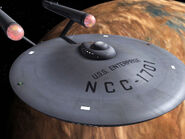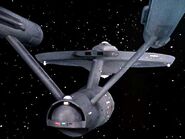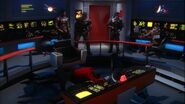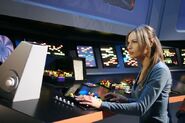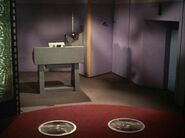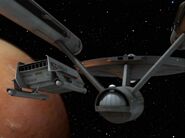m (grammar, format) |
(→The eleven-foot studio model: text add.) |
||
| Line 488: | Line 488: | ||
The wooden secondary hull was subcontracted out, as well as several component pieces such as metal bits on the nacelles. The spikes on the forward nacelle domes were made by Datin himself. The same paint scheme as for the three-footer was applied, but no decals were used on this version, all the details on the hull, lettering, logos and all were painted on. Virtually identical to her smaller sister, the eleven-footer lacked one detail. The surface on the backside of the aft nacelle caps was smooth, where the three-footer, as per specification, sported a detailed rectangular feature. |
The wooden secondary hull was subcontracted out, as well as several component pieces such as metal bits on the nacelles. The spikes on the forward nacelle domes were made by Datin himself. The same paint scheme as for the three-footer was applied, but no decals were used on this version, all the details on the hull, lettering, logos and all were painted on. Virtually identical to her smaller sister, the eleven-footer lacked one detail. The surface on the backside of the aft nacelle caps was smooth, where the three-footer, as per specification, sported a detailed rectangular feature. |
||
| − | |||
Coming in at a length of 11ft, 2.08inch and a weight of 225 pound the model was delivered to Anderson on 29 December 1964. Too late for extensive use for "The Cage", the model was stored away for months while the studio pondered the fate of ''Star Trek''. |
Coming in at a length of 11ft, 2.08inch and a weight of 225 pound the model was delivered to Anderson on 29 December 1964. Too late for extensive use for "The Cage", the model was stored away for months while the studio pondered the fate of ''Star Trek''. |
||
| + | Once the decision was made to have a second pilot made, Roddenberry with the people at Anderson's decided to enliven the large model in order to enhance their chances. Up to then he didn't want any of the models to be internally lightened and the models were delivered as such, however he changed his mind about that. Again Richard Datin was called in to do the proposed revisions. Datin logged in another 88 hours of his work from 27 Augustus to 8 September 1965, doing the following: |
||
| + | *Bridge: several painted-on windows removed, light panels added in front and on sides. |
||
| + | *Saucer top: nav lights added, black bands painted near port & starboard edge, painted black & white areas added near bow edge, four light panels added. The port & aft light panel was just painted-on and is not an actual light panel. |
||
| + | *Saucer rim: centermost bow port changed to nav light, some windows added. |
||
| + | *Saucer bottom: nav light & 2 portholes added near edge on each side, at 10 and 2 o'clock positions. |
||
| + | *Impulse engines: black rectangular vents painted over with hull color, eight small round black vents painted on. |
||
| + | *Secondary hull: strobe light added on aft flank, rearmost round porthole moved from left side of two rectangular ones to right side. |
||
| + | *Nacelles: black "grille" pattern painted on rear nacelle end caps. |
||
| + | *Registry markings were previously painted-on, now changed to decals. |
||
| + | The moment ''Star Trek'' was to become a regular series early 1966, Roddenberry wanted to enliven the model even more, this time also retrofitted to the "three-footer". Yet again Datin was called in to do the revisions, What he did was this: |
||
| + | *Bridge: bottom half chopped off, light panels removed, a red "beacon" added on each side. Some portholes added on B&C decks. |
||
| + | *Saucer top: black bands and most other painted-on markings removed, a round light panel added near bow edge, rib added on "linear accelerator" and both painted a darker gray. |
||
| + | *Saucer rim: Some portholes added, bow nav light replaced by light panel |
||
| + | *Saucer bottom: nav lights moved to 9 and 3 o'clock position, some portholes added, "nipple with phaser turret" added below sensor dome. |
||
| + | *Impulse engines: painted darker gray, round vents removed, original rectangular vents again painted black, texture wraps added on both ends of impulse deck. |
||
| + | *Dorsal: some windows/portholes moved/added, dorsal painted same as rest of hull instead of the earlier bluish reflective color, with a darker region on both leading & receding edge. |
||
| + | *Secondary hull: red "beacon" & green portholes added on top, some windows/portholes added, deflector dish diameter reduced, "observation booth" added under cowling above hangar bay doors. |
||
| + | *Nacelle pylons: four dark gray. brick-pattern inserts placed in slots. |
||
| + | *Nacelles: solid wood "power nodules" with spikes replaced with frosted plexiglas domes with inner surface painted transparent orange, plus motorized vanes and blinking Christmas lights added behind the dome[http://meshula.net/daystrom/1701/1701_1.html]. The original wooden domes are still in the possession of Richard Datin. |
||
| + | *Ribs and aluminum grille added in "trenches" along inboard flanks of nacelles and trench painted darker gray., patterned slabs added inside "intercooler loops" at rear, small slabs added in front of intercooler loops, black painted grille removed from end caps and light gray. spheres added. |
||
| + | *Typeface used for registry markings changed, weathering added. |
||
| + | |||
| + | These revisions are the ones also retrofitted onto the three-footer, save for the lighting options which were deemed too expensive. In this vane the eleven-foot ''Enterprise ''-model would be used for the rest of the series, save for minor revisions done at Anderson's during the run of the series: |
||
| + | *Upper sensor dome changed to a taller one, registry numbers on saucer bottom switched around so the starboard one was readable from a front view. |
||
| + | *Jefferies came up with a "deflector grid" which was drawn in pencil on the primary hull. It was drawn only to satisfy Roddenberry and was done very lightly so it wouldn't be visible on film. |
||
=== Apocrypha === |
=== Apocrypha === |
||
Revision as of 02:11, 19 September 2009
- For the alternate version of the Constitution-class created following Nero's incursion, see Constitution class (alternate reality)
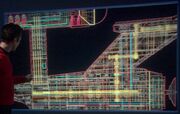
A schematic of the starship USS Defiant (NCC-1764)
The Constitution-class starships, which were also known as Starship-class or Class I Heavy Cruisers, were the premier front-line Starfleet vessels in the latter half of the 23rd century. They were designed for long duration missions with minimal outside support and are best known for their celebrated missions of galactic exploration and diplomacy which typically lasted up to five years.
History
The Constitution-class lineage was launched some time prior to 2245, and served as Starfleet's front-line vessels for the rest of the century. The Constitution-class also served as a mighty deterrent to both the Klingon Empire and the Romulan Star Empire, several times taking part in combat actions which determined the fate of the entire Federation if not the Alpha Quadrant itself. (Star Trek Encyclopedia)
In 2267, there were around twelve1 Constitution-class starships in the fleet. (TOS: "Tomorrow is Yesterday") These included the NCC-1700, the USS Constellation, the USS Defiant, the USS Enterprise, the USS Excalibur, the USS Exeter, the USS Hood, the USS Intrepid, USS Lexington, and the USS Potemkin.
The most famous Constitution-class starship was the USS Enterprise (NCC-1701), launched under the command of Captain Robert April in 2245. The Enterprise gained its reputation during its historic five year mission (2265-2270) under the command of Captain James T. Kirk. (VOY: "Q2")
In 2266, on stardate 1709, the Enterprise was instrumental in preventing a war between the Federation and the Romulan Star Empire. When a Romulan Bird-of-Prey crossed the Romulan Neutral Zone and destroyed several Earth Outpost Stations, Captain Kirk barely managed to outwit the enemy commander and stop his vessel from returning to Romulus and reporting on the Federation's weakness. (TOS: "Balance of Terror")
In late-2268, Excalibur, Hood, Lexington, and Potemkin took part in the disastrous testing of the M-5 computer, which had been placed in control of the Enterprise. The Excalibur was severely damaged, with all hands lost. The Lexington also was brutally assaulted by the M-5 computer when the unit became unstable. (TOS: "The Ultimate Computer")
Later that year, Defiant responded to a distress call from an unexplored sector of space, claimed by the Tholian Assembly. Shortly upon entering the region, the Defiant crew began experiencing sensory distortion, and insanity quickly spread throughout the ship. The ship's surgeon was unable to determine what was happening, and eventually the insanity induced by the phenomenon lead the crew to kill each other.
Three weeks later, Starfleet ordered the Enterprise to mount a search mission to locate the Defiant. On stardate 5693.2, the Enterprise located her adrift, lost between universes in a space warp. As a result of a later phaser exchange between the Enterprise and several Tholian vessels, a hole was created through the spatial interphase, pushing the Defiant into the mirror universe. (TOS: "The Tholian Web")
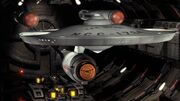
The Defiant in a Tholian drydock facility
Unknown to history in the "prime" universe, the Defiant emerged in the 22nd century mirror universe, where the Tholians of that universe had created the interphase rift by detonating a tricobalt warhead within the gravity well of a dead star. (ENT: "In a Mirror, Darkly") The Defiant would seemingly go on to play a major role in Empress Sato's rule over the Earth. (ENT: "In a Mirror, Darkly, Part II")
- It is unclear whether, following the events of ENT: "In a Mirror, Darkly, Part II", Sato's bid to become Empress actually succeeded, or what the final disposition of the Defiant in that universe was, as the mirror universe of the 23rd century, as can be seen in TOS: "Mirror, Mirror", exhibits no significant advances in technology nor any evidence of knowledge of the "real" universe.
Refit history
USS Enterprise - bridge module in 2265
USS Enterprise - impulse and warp drive in 2265
Constitution-refit configuration since 2270s
Constitution-refit configuration aft view
From 2254, or earlier, to 2265 Constitution-class vessels featured a large deflector dish, a large bridge dome of semi-spherical shape, and an antenna spike protruding from the Bussard collector cap on each warp nacelle. The impulse drive had two exhaust vents in 2254, and as many as eight smaller vents in 2265. (TOS: "The Cage", "Where No Man Has Gone Before")
Sometime between 2265 and 2266 the vessels underwent a major overhaul: the old deflector dish was replaced by a significantly smaller model, the spikes on the Bussard collectors were removed, a smaller bridge dome of flatter curvature was installed, the aft caps on the warp nacelles were each equipped with a spherical attachment, and the impulse drive now had only two large exhausts. (TOS: "The Corbomite Maneuver")
- The changes to the impulse drive section may indicate that completely new impulse engines were installed. It is unclear whether the warp nacelles were merely modified or completely replaced.
The interior passageways, main bridge interior and briefing room were already redesigned sometime between 2254 and 2265, and new intercoms were installed.
In 2266, the interior passageways were again modified, the briefing room was completely redesigned, and the overhauled main bridge featured an enlarged main viewscreen and upgrades to the control interfaces and station arrangement, but the overall appearance of the bridge remained relatively unchanged as compared to 2265. (TOS: "The Corbomite Maneuver")
The crew quarters of the 2254 configuration had the capability of carrying slightly more than 200 crewmembers. (TOS: "The Cage") In the 2266 configuration, crew quarters could hold a crew complement of over 400. (TOS: "Charlie X")
In the late 2260s to early 2270s, the Constitution-class starships underwent their final major refit program. The actual refitting took eighteen months of work and essentially a new vessel was built onto the bones of the old, replacing virtually every major system. Thus, the Constitution-class continued in service for a further twenty years.
Essential upgrades were made to the Constitution-class' warp systems; the old cylindrical nacelles were replaced with new angular ones, and also the warp nacelle struts were new, as they were connected to the engineering hull much closer to the neck than before. The engineering hull roughly retained its original shape – while the original hull was essentially a conical cylinder, the refit was much more rounded.
The deflector dish was upgraded, doing away with the "satellite" dish architecture. As for the interior of the hull, the most obvious upgrades were the enlargement of the shuttle deck and landing bay, as well as the addition of a horizontal matter-antimatter reaction assembly and a vertical intermix chamber.
New also was the installment of the double photon torpedo launcher with its rectangular housing in the neck of the vessel. Also, the phaser configuration was changed to channel energy though the warp core. Furthermore, the saucer section was considerably extended (almost 20 meters), while the rest of the surface remained about the same.
Major changes were made to the interior of the Constitution-class starships; many new systems were added and existing ones upgraded. Summarizing, only the internal structure of the saucer and very little of the engineering hull and neck may have survived the 2270s refit. (Star Trek: The Motion Picture)
Some refit configurations had the warp nacelles rotated 90 degrees and included additional hatches along both sides of the saucer. (TNG: "Booby Trap")
Technical data
Physical arrangement
The Constitution-class featured the saucer section-engineering section-warp nacelle layout common to most Starfleet vessels. (TOS: "The Cage"; Star Trek: The Motion Picture; etc.)
The redesigned Enterprise has a sleeker, more modern look compared to the original configuration in the TOS era. However it still maintains the original saucer section-engineering section-warp nacelle layout. The saucer section seems to reflect the design of the TOS-Movie Era design, especially with the exterior bridge design.
Various science labs, numbering fourteen in all, (TOS: "Operation -- Annihilate!") were located in the primary hull in the class' original configuration. An officer's lounge and dining area would be located in the aft superstructure beneath the bridge after the 2270s refit. (Star Trek: The Motion Picture)
The modular design of the Constitution-class allowed for component separation in times of crisis. The primary and secondary hulls could separate where the connecting "neck" joined the saucer, allowing either section to serve as a lifeboat if the other was too badly damaged. If an emergency was confined to the warp engine nacelles, it was theoretically possible to disengage and jettison them while keeping the bulk of the vessel intact. Any hull separation was considered a dangerous procedure and not always an option.(TOS: "The Apple", "The Savage Curtain")
Though not an aerodynamic craft, in emergencies, Constitution-class vessels were able to break orbit and enter a Class M planet's upper atmosphere (and maintain attitude control while passing through it) for a limited period of time, conditional on the ship's ability to re-achieve escape velocity. (TOS: "Tomorrow is Yesterday")
Command and control systems
The Constitution-class's primary command center, the main bridge, was located on top of the vessel's primary hull, on Deck 1. From here, the commanding officer supervised the entire starship's operation.
The command chair was located in the recessed area at the center of the room, in a direct line with the main viewer. This position was equidistant from all the control consoles that operated specific areas of the ship. Consequently, the captain could be immediately updated on the condition of the vessel or its crew during missions, and orders could be given clearly with a minimum of effort.
The chair was mounted on a circular pillar, attached to a rectangular footplate that was directly anchored to the deck, giving it considerable support during an attack. It was designed to swivel on the support so that the captain could turn to any member of the bridge crew.
Piloting and navigation functions were carried out at the helm console, located in the center of the room, positioned in front of the command chair. This panel consisted of three main sections.
On the left was a compartment which opened automatically to permit operation of the targeting scanner. Next to this was the main control panel, which operated maneuvering thrusters, impulse engines, and fired the ship's weapons. Directly below this panel was a row of eight flip-switches provided to set warp flight speeds.
The central section of the conn panel was fitted with a number of sensor monitor lights, and was dominated by two main features: the alert indicator and the astrogator, which was used for long-range course plotting.
The navigator's station had a control panel for entering course and heading data and the flight path indicator, and supplied information on any deviations or course corrections in progress. It also had controls for the weapons systems.
Other stations on the bridge were provided for communications, engineering, weapons control, gravity control, damage control, environmental engineering, science and library computer, and internal security. All stations were normally manned at all times.
Mounted into the room's forward bulkhead was the main viewscreen. Visual sensor pickups located at various points on the Constitution-class' outer hull were capable of image magnification and allowed a varied choice of viewing angles.
The computer systems aboard the Constitution-class starship were duotronic based. (TOS: "The Ultimate Computer"; DS9: "Trials and Tribble-ations")
Upgrades
Only one turbolift serviced the bridge of the original configuration Constitution-class ship. In the late 2260s, some were refit with a second lift on the port forward section of the bridge. (TAS: "Beyond the Farthest Star") After the major refit in the early 2270s, the bridge aboard Constitution-class vessels would continue to utilize two turbolifts, but both would be located behind the command chair. (Star Trek: The Motion Picture)
Main bridge of the USS Enterprise (2269)
- The Star Fleet Technical Manual, states that the original bridge was rotated 36° port, which would have the turbolift shaft travel down the centerline of the saucer section. The Technical Manual gives no reason for this offset. With artificial gravity limiting any sense of momentum and electronic displays instead of windows, there may have been no reason for the bridge crew to face directly forward.
- According to production designer Matt Jeffries, dramatic necessity required the turbolift to be moved from its planned centerline position (as seen on the Enterprise model). This off-set placement allowed characters to walk onto the bridge and enter scenes without being blocked by actors sitting in the command chair.
Refit configuration bridge (2270s)
The bridge of the Constitution-class starships were subject to many minor and major cosmetic changes over their many years of service. In particular, the main bridge of the USS Enterprise seems to have undergone considerable changes in appearance. In the late 2260s, along with the added turbolift, the bridge design changed from a segmented flat-panel peripheral station configuration to a completely circular design, including curved overhead view screens, and railings and steps which matched the arc of the circumference. At the same time, an automatic bridge defense system was also installed that obscured the translucent overhead dome, which would not return until the Galaxy class bridge. (TAS: "Beyond the Farthest Star") This marked the beginning of major changes to come which would utilize the updaated substructure, most notably, its systems were fully upgraded along with the refit of the early 2270s. (Star Trek: The Motion Picture)
Refit configuration bridge (2286)
The bridge underwent only a few minor modifications from that point until the destruction of the ship in 2285. The bridge of the USS Enterprise-A, commissioned one year later (in 2286), had mainly cosmetic differences at launch, but, by 2287, it had been drastically upgraded to reflect the advances made in computer control technology.
Refit configuration bridge (2293)
The bridge module had again been replaced by 2293. The lighter color scheme of the original Enterprise-A bridges had made room for a darker, more militaristic look. (Star Trek II: The Wrath of Khan; Star Trek IV: The Voyage Home; Star Trek V: The Final Frontier; Star Trek VI: The Undiscovered Country)
- The controls in the fifth movie were designed to reflect a change towards a more TNG control style, but in the sixth movie the controls went back to a more push button design. While this has not been addressed in the canon one might theorize that the controls were replaced for any variety of reasons.
Propulsion systems
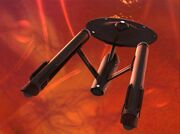
Aft view of an original configuration vessel
The Constitution-class of starships has been fitted with both lithium and dilithium reactor circuits in the warp drive assembly over its service lifetime. The vessel's standard cruising speed was warp 6, while its maximum cruising speed was warp 8. Warp 9 was also possible for this class of starship, although it was highly discouraged because it was an unsafe velocity.
The USS Enterprise was twice modified to achieve a speed of warp 11. The probe Nomad increased the ship's engine efficiency by 57% in 2267, allowing the ship to reach warp 11, but Kirk persuaded Nomad to reverse its "repairs" because the ship's structure could not stand the stress of that much power, and would eventually destroy the ship. (TOS: "The Changeling")
More extensive modifications made to the ship by the Kelvans in 2268, who were able to produce velocities that were far beyond the reach of Federation science, allowing the Enterprise to safely maintain a cruising speed of warp 11 while traveling through the intergalactic void. (TOS: "By Any Other Name")
The maximum warp speed recorded for this class by itself was warp 14.1, achieved by the Enterprise due to sabotage to the vessel's warp drive system. While the ship itself was not structured to take that speed for any length of time, the Enterprise was able to maintain that velocity for nearly 15 minutes. (TOS: "That Which Survives")
The Enterprise also maintained stability at warp 22, while tractored to a ship going warp 32. (TAS: "The Counter-Clock Incident")
A close-up of the refit configuration impulse drive
Following the 2270s refit of the class, the Constitution was equipped with a linear dilithium-controlled MARA (Matter/Antimatter Reactor Assembly), and a pulse dilithium-controlled assembly was installed by the mid 2290s aboard the USS Enterprise. (Star Trek II: The Wrath of Khan; Star Trek VI: The Undiscovered Country)
The Constitution-class' impulse drive system was a twin-port fusion reactor engine, capable of velocities at least 0.8c. (Star Trek: The Motion Picture) A fusion explosion equivalent to at least 97.835 megatons would result if the impulse engines were overloaded. (TOS: "The Doomsday Machine")
Main engineering
Main engineering was from where the ship's warp was controlled. All thrust and power systems were primarily controlled from this site, and it is also where the main dilithium crystal reactor was located. Life support was controlled separately from Deck 6. (TOS: "The Ultimate Computer", "The Corbomite Maneuver", "The Naked Time", "The Enemy Within", "The Conscience of the King", and more)
During the 2270s Constitution-class refit, the interior design of the engineering section was drastically upgraded, featuring the vertical warp core and the horizontal intermix area.
Main engineering was lodged on Decks 14 and 15. Deck 14 was the uppermost level of the engineering hull, and was the anchoring framework for the connecting dorsal and the warp nacelle pylons.
On the forward end of the deck was the engineering computer monitoring room, which encircled the cortical intermix shaft and opens, to the rear, into the engineering computer bay.
Deck 15 housed the main engineering room. Located in the center of the room, and extending for many levels both above and below the deck, was the vertical linear intermix chamber. This complex, radically new design in intermix technology, provided operational power for the impulse drive system and furnished enough additional energy to power all other shipboard systems.
Both matter and antimatter for this chamber were contained in a series of magnetic bottles, which were housed in pods at the base of the intermix shaft. (Star Trek: The Motion Picture)
Tactical systems

Forward phasers of the USS Enterprise
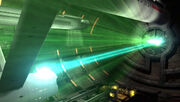
Original configuration Constitution-class USS Defiant firing its secondary hull aft phasers
A refit Constitution vessel fires its forward phasers
During the early 2250s, Constitution-class heavy cruisers were armed with a complement of directed energy weapons, that possessed enough power to destroy half a continent in a concentrated bombardment. In addition, these vessels carried on board laser cannons, capable of operating on energy fed remotely from the ship. (TOS: "The Cage", "The Menagerie, Part I", "The Menagerie, Part II")
By 2266, phaser banks were standard complement aboard this class of ship. A bank actually consisted of a single emitter and its power supply, though it was common practice to fire two banks at a time and refer to it as a single firing. (TOS: "The Corbomite Maneuver", "The Doomsday Machine", "The Paradise Syndrome")
Ship-mounted phaser banks had a range of approximately 90,000 kilometers, and like hand phasers, were capable of being adjusted to stun, heat, or disintegrate visible targets, including objects or beings in space or on a planet's surface at a focus ranging from narrow to wide beam. When only motion sensor readings are available, ships' phasers could be set for proximity blast and bracket the approximate coordinates of the target. (TOS: "Balance of Terror", "A Piece of the Action", "Who Mourns for Adonais?", "The Paradise Syndrome", "The Tholian Web")
In the original configuration, a battery of four to eight forward phaser banks were located on the lower part of the ventral side of the saucer section. Aft firing banks were located above the shuttlebay on the secondary hull. There were also port, starboard and midship phasers. (ENT: "In a Mirror, Darkly, Part II"; TOS: "Balance of Terror", "The Paradise Syndrome", "Arena", "Friday's Child").
- It is not clear where the additional banks mentioned in background dialogue and in several episodes were located. The top view graphic of the original Constitution-class configuration, used on a computer screen in Star Trek III: The Search for Spock, places port and starboard emitters on the dorsal surface of the primary hull. Two emitters cover both flanks.
The diversion of all but emergency maintenance power to the shields had the adverse affect of reducing phaser power by fifty percent. (TOS: "The Tholian Web")
The Constitution-class originally mounted at least six torpedo launchers, one tube covering the aft firing arc. Forward tubes were located in the same area as the forward phaser banks. The aft tube fired from the end of the secondary hull. This combined arsenal was powerful enough to destroy the entire surface of a planet. (TOS: "Arena", "A Taste of Armageddon", "Journey to Babel"; TAS: "More Tribbles, More Troubles"; ENT: "In a Mirror, Darkly, Part II")
- Numerous inconsistencies originally existed between the dialogue and the special effects depicting the weapons of a Constitution-class ship. Many of those were corrected by the Remastered episodes effects shots, but some remain, making it impossible to formulate a conclusive assessment of the exact armaments of the original Constitution-class starship. Number of torpedo launchers is based on the line of dialogue "fire photon torpedoes two, four and six" from "Journey to Babel".
Torpedo bay (refit configuration)
After the refit of the 2270s, Constitution-class ships mounted three dual-emitter phaser banks on the ventral and three on dorsal faces of the saucer. They covered the forward, port and starboard flanks. Two single emitter aft banks are above the shuttlebay and four midship single emitter banks are located on the ventral surface of the engineering hull.
Phaser power was increased by drawing energy directly from the warp drive. This increase in firepower had a drawback in that the phasers would be cut off if the main reactor was off line. This problem hampered the USS Enterprise on at least two occasions, one in 2272 and again in 2283.
The post-refit vessels had two forward firing torpedo launchers, though each tube could fire at least two torpedoes before reloading. (Star Trek: The Motion Picture; Star Trek II: The Wrath of Khan; Star Trek III: The Search for Spock)
Transporter systems
Extravehicular transporter to and from the ship was accomplished by a number of transporter systems, which allowed personnel or equipment to be transported over large ranges. The transporter platform featured six pads, which were numbered clockwise, beginning with the right front. A redesigned field generator matrix was mounted into the rear wall of the chamber aboard the refit configuration Constitution-class starships.
Aboard the refitted Constitution-class vessels, the transporter operator stood within an enclosed control pod, which had a floor-to-ceiling transparent aluminum panel through which he or she could view the transport platform. This panel served to shield the operator from the effects of any cumulative radiations emitted by the new transporter machinery, a side effect of the more powerful system.
A door in the standard transporter room wall led to a staging area where landing parties prepared for transporter.
Airlocks
Airlock staging area in 2272
Refit Constitution-class starships possessed a number of airlocks permitting direct physical access to the ship. One was located at the aft of Deck 1 on top of the saucer section. Two more were located in the lower saucer section, port and starboard, concealed by sliding hull plates. (Star Trek: The Motion Picture)
- One of these, [port], is shown in the "Spock walk" sequence. Since nearly every other such airlock has a matching one on the other side of the ship, it is reasonable to assume the presence of one to starboard.
These lower two are accessed through staging areas. Four spacesuit lockers line one wall; each containing one suit, providing enough to clothe a standard party of four. A small, locked arms cabinet held phasers; communicators, tricorders, translators, and outerwear were contained in a separate cabinet on another wall. (Star Trek: The Motion Picture)
The next set of airlocks were located on the port and starboard sides of the torpedo bays. The final set were located on the port and starboard sides of the secondary hull at the midline. (Star Trek: The Motion Picture; Star Trek II: The Wrath of Khan) These airlocks opened into the ship's main cargo bay. There was also a "gangway"-style airlock on the port edge of the saucer section. (Star Trek: The Motion Picture)
- The presence of a similar "passageway" visible in the Tholian drydock holding the USS Defiant suggests that it is a feature of the pre-refit Constitution-class as well. (ENT: "In a Mirror, Darkly")
Located on the upper surface of the saucer section of the refitted Enterprise were numerous small hatches used for entrance/egress during extra-vehicular activities. (Kirk, Spock, Decker, McCoy, and the Ilia probe use one of these hatches to leave the ship when they arrive at V'Gers "core".) (Star Trek: The Motion Picture)
Landing bay and cargo facilities
Deck 17 was the main access level of the engineering hull. The aft landing bay provided personnel in small craft with a means of entering or exiting the vessel, as did docking port on either side of the level.
The original configuration of the Constitution-class carried a standard complement of 4 Class F shuttlecraft. (TOS: "The Omega Glory")
The refit configuration Constitution-class starship featured a new landing bay design. A wide range of Starfleet and Federation craft could utilize this state-of-the-art landing facility.
Alcoves on either side of the landing bay provided storage for up to six standard Work Bees, and furnished all necessary recharging and refueling equipment. Additional space was available for the storage of non-ship shuttlecraft.
Just within the landing bay doors was a force field generator unit, which was built into the main bulkheads on either side of the entry area. This field allowed craft to enter the ship, while at the same time retaining the atmosphere and temperature within the landing bay.
Deck 18, the refit configuration shuttlecraft hanger bay, was situated at the widest point of the engineering hull. Much of the deck consisted of open space, as it was the mid-level of the cargo facility; thirty-two cargo pod modules could be stored in the alcoves lining the forward, port, and starboard sides of the bay.
The shuttle hangar had sufficient room for the storage of four craft at any given time. During normal storage situations, these shuttlecraft faced aft.
This deck also housed the vessel's lifeboat facilities. These one-man craft, which escaped through blow-away panels in the side of the secondary hull, were provided for those persons were unable to reach the primary hull in case of an emergency. (Star Trek: The Motion Picture)
Crew support systems
Medical systems
On the original Constitution-class starships, a sickbay facility was located on Deck 6, which featured an examination room, a nursery, the chief medical officer's office and a medical lab. At least one other medical lab was located elsewhere on the vessel, and was used for biopsy, among other things. Sickbay was considered the safest place to be on the ship during combat. (TOS: "The Naked Time", "Elaan of Troyius")
- The sickbay set of the pilot episode "Where No Man Has Gone Before" underwent considerable changes following the shooting of the episode for the remainder of the series.
With the class refit of the 2270s, the medical facilities of the Constitution-class starship were considerably updated. New micro-diagnostic tables were capable of fully analyzing the humanoid body at the sub-cellular level, offering the physician a total understanding of the patient's status.
Another new addition was a medical stasis unit, in which patients whose conditions were considered immediately life-threatening could be placed into suspended animation until the proper cure or surgical procedure could be established. (Star Trek: The Motion Picture)
Crew quarters
Crew quarters in the 2260s
Senior officers' quarters on an original Constitution
Officers' quarters on a refit configuration Constitution
Crew quarters were located throughout the saucer section – keeping with Starfleet tradition, Deck 5 housed the senior officers' quarters. On the refit configuration vessels, these staterooms were quite similar to the VIP units on Deck 4, with only a few differences.
On starships of the original configuration, the officers' quarters featured two areas, separated partly by a wall fragment. One area was allocated as sleeping area, featuring a comfortable bed, and another as work area, including a desk and computer terminal. Entrance to a bathroom was provided through the quarter's sleeping area. Both areas could be configured to personal preference. (ENT: "In a Mirror, Darkly, Part II"; TOS: "The Enemy Within")
- On the original series, several "different" crew quarters were seen, but always the same set was used, changed by different lighting designs and furniture configuration.
On Constitution-class vessels of the staterooms of the senior officers were composed of two areas which were separated by a retractable, transparent aluminum partition. The room's entrance opened into the living area. A library computer terminal and work desk were provided here. The room's corner circular nook, normally occupied by a dining booth, could be modified at the officer's request.
The other half of the stateroom was a sleeping area, which held a single large bed that could double as sofa during off-duty relaxation. A transparent door led into the bathroom area. By the 2290s, crew space was at a premium, and the size of officers' quarters was reduced to one large room and crewmen were housed in dormitories with bunk beds. (Star Trek: The Motion Picture; Star Trek VI: The Undiscovered Country)
A typical recreation room (2260s)
Recreational facilities
Recreation room (refit configuration, 2270s)
Aboard the original Constitution-class starships, there were at least six recreation rooms, which included three-dimensional chess and card game tables. There was also a holographic rec room, which was the predecessor of the holodeck. Also aboard were as arboretum, gymnasium, a bowling alley, a theater, and a chapel. (TOS: "Charlie X", "The Naked Time", "The Conscience of the King"; Star Trek: The Motion Picture))
On the refitted Constitution-class vessels, recreational facilities were further expanded. One large room in the aft section of the starship's saucer section furnished off-duty personnel with a wide variety of recreational games and entertainment.
At the front of the room was an immense, wall-mounted viewing screen. Beneath this was an information display alcove; five small screens exhibited, upon request, a choice of pictorial histories. A raised platform in the center of the lower level floor featured a diversity of electronic entertainment. (Star Trek: The Motion Picture)
Officers' lounge privacy area on a Constitution-class vessel of the refit lineage
Officers' lounge
Located at the stern of Deck 2 aboard the refit configuration Constitution-class starship was the officers' lounge. Here, four huge view ports afforded a spectacular view of the ship's warp nacelles and space beyond.
To the sides, small plant areas held flora from several worlds and a small pool featured freshwater tropical fish. Just forward of this section of the lounge were two privacy areas. In each privacy area, a view screen was mounted into the wall, providing a full exterior tour of the vessel. (Star Trek: The Motion Picture)
Ships commissioned
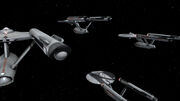
Four Constitutions fly in formation
- USS Constellation (NCC-1017)
- USS Intrepid (NCC-1631)
- USS Potemkin (NCC-1657)
- USS Excalibur (NCC-1664)
- USS Exeter (NCC-1672)
- NCC-1700
- USS Enterprise (NCC-1701)
- USS Enterprise (NCC-1701-A)
- USS Hood (NCC-1703)
- NCC-1707
- USS Lexington (NCC-1709)
- USS Defiant (NCC-1764)
- Alternate
- ISS Enterprise (NCC-1701) (in the mirror universe)
- USS Enterprise (NCC-1701) (in at least one alternate timeline)
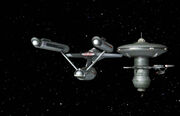
The Enterprise and the Lexington at Starbase 6
- Unnamed
- Uncertain
- USS Eagle (NCC-956)
- USS Republic (NCC-1371)
- USS Scovil (NCC-1598)
- USS Kongo (NCC-1710)
- USS Merrimac (NCC-1715)
- NCC-1831
- USS Emden (NCC-1856)
- USS Endeavour (NCC-1895)
- USS Challenger (NCC-2032)
- USS Ahwahnee (NCC-2048)
- USS Farragut
- USS Yorktown
Appendices
Appearances
The Constitution-class Enterprise appeared in every episode of TOS and TAS (except for "The Slaver Weapon"). TOS episodes featuring other Constitution-class vessels besides Enterprise are listed below.
- TOS:
- "Court Martial" remastered
- "The Doomsday Machine"
- "The Ultimate Computer"
- "The Omega Glory"
- "The Tholian Web"
- Star Trek films:
'** Star Trek V: The Final Frontier
- TNG:
- "Lonely Among Us" (model)
- "The Battle" (model)
- "Hide and Q" (model)
- "Haven" (model)
- "The Big Goodbye" (model)
- "The Bonding" (model)
- "Booby Trap" (model)
- "The Best of Both Worlds" (wreckage)
- "The First Duty" (model)
- "Relics"(bridge)
- DS9:
- "Homefront" (model)
- "Paradise Lost" (model)
- "Trials and Tribble-ations"
- "What You Leave Behind" (corridor in montage scene)
- VOY: "In the Flesh" (wall display, original and refit)
- ENT:
Background
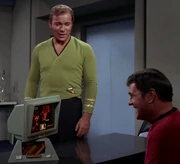
An early computer graphic listed the first mention of the name of the Constitution-class
While probably discussed or originated in behind-the-scenes proposals and communications, the name "Constitution-class" originated in canon productions only as an unreadable graphic on a computer screen of a phaser diagram from Scotty's technical journal, in TOS: "The Trouble with Tribbles". Authors of reference works such as the Star Fleet Technical Manual were privy to the fact that Enterprise herself was Constitution-class, even though it had never been mentioned in dialog or been readable on screen. Technical Manual drawings by Franz Joseph with the class name appeared on screen, again mostly unreadable, in Star Trek II: The Wrath of Khan and Star Trek III: The Search for Spock. These were the first occasions a canon production assigned the Constitution name to the class design of the Enterprise. Star Trek IV: The Voyage Home assigned this class name to the refit Enterprise as well, although some production staff previously and, apparently, unofficially called that design Template:ShipClass. The name Enterprise-class was also used in reference to the refitted Enterprise and the Enterprise-A in Mr. Scott's Guide to the Enterprise. However, that particular book is not considered canonical. The class name wasn't mentioned in dialog until 1987's Star Trek: The Next Generation episode "The Naked Now". The name has been mentioned numerous times and been more prominently visible in later series and episodes referencing ships of the TOS and movies design.
Design
As art director on the original series, Matt Jefferies was given the assignment to design the Enterprise itself. His only guidelines were Gene Roddenberry's firm list of what he did not want to see: not any rockets, nor jets, nor fire streams. The starship was not to look like a classic, and thus dated, science-fiction rocket ship, but neither could it resemble anything that would too quickly date the design. Somewhere between the cartoons of the past and the reality of the present, Matt Jefferies had to give at a design of the future.
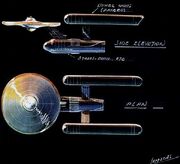
The sketch Gene Roddenberry and Herb Solow approved
The theory that space could be warped was first proposed by Albert Einstein in 1905, and first demonstrated, according to Star Trek canon, by Zefram Cochrane in 2063, providing that objects could travel faster than the speed of light. Warp drive is a delicately balanced, intricate web of chemistry, physics, mathematics, and mystery.
"I was concerned about the design of ship that Gene told me would have 'warp' drive," Jefferies explained. "I thought, 'What the hell is warp drive?' But I gathered that this ship had to have powerful engines – extremely powerful. To me, that meant that they had to be designed away from the body. Boy, I tried a lot of ideas. I wanted to stay away from the flying saucer shape. The ball or sphere, as you'll see in some of the sketches, was my idea, but I ended up with the saucer after all. Gene would come in to look over what I was doing and say, 'I don't like this,' or, 'This looks good.' If Gene liked it, he'd ask the Boss (Herb Solow) and if the Boss liked it, then I'd work on that idea for a while."

The model
"So I worked on it for a while, and a couple of weeks later Herb and Gene came in. They liked a bit of this and a bit of that, and I worked on those bits. And then I came up with something I really like, so I preloaded it – used lots of color and put it in a prominent place that made it kind of stand out. And that worked! It looked better than the other sketches and Gene said, 'That one looks good!' They – and Bobby Justman, too, when he came aboard later – were a dream to work with." (Star Trek: The Original Series Sketchbook, page 62)
The designing process itself however, proved to be arduous and time consuming. Starting from Roddenberry's ambiguous guidelines, Jefferies started out with experimenting with shapes. As he recalls:"(...)There was a lot of floundering going on because I didn't know where the hell we were going and I had to start coming up with an envelope to work inside of. I did hundreds of sketches. Gene liked a piece of this and a piece of something else, so I tried to see what I could do with the pieces.". Dozens more sketches followed, experimenting with the configuration of the selected components:"My thinking was, because of the ship's speed there had to be terrifically powerful engines. They might be dangerous to be around, so maybe we'd better put them out of the way somewhere, which would also make them what in aviation circles we call the QCU-quick change units-where you could easily take one off and put another on. Then for the hull, I didn't really want a saucer because of the term "flying saucer", and the best pressure vessel of course is a ball, so I started playing with that. But the bulk got in the way and the ball just didn't work. I flattened it out and I guess we wound up with a saucer!"(Star Trek: The Magazine Volume 1, Issue 10, page 25). By the time Jefferies came upon the (color)design that was approved upon, he also had a small balsa wood miniature made, to give Roddenberry and the NBC execs a three dimensional feel for the ship. Theorizing that space was too hazardous for important machinery being on the outside of the hull. Jefferies decided that the hull had to be smooth (which had the added benefit of reflecting light in subsequent shoots). He had to fight off several production team members, who wanted to keep adding detail to the surface. In the end Jefferies spend full time the better part of a month, designing the ship.
Interestingly, two of Jefferies' earlier designs would capture the imaginations of later Star Trek production team members, like Rick Sternbach, Andrew Probert, Michael Okuda and Gregory Jein. Through their fascination and persistence, these designs would eventually find their way into Canon; A "ring ship" design (dismissed by Roddenberry as being too frail looking) would become the USS Enterprise (XCV 330), and the ball shaped primary hull design, which Jefferies himself dismissed, would be the foremost influence on the design of the Daedalus class.
Registry Number
Jefferies was also responsible for the famous Registrynumber NCC 1701. As he explains:"Since the 1920's, N has indicated the United States in Navy terms, and C means 'commercial' vessel. I added an extra C just for fun. Interestingly, Russia's designation is CCC. So The N and C together made it kind of international. After that, I had to pick some numbers. They had to be easily identifiable from a distance, so that eliminated 3, 8 , 6, 9 and 4-none of which is that clear from a distance, That didn't leave much! So 1701 was a s good a choice as any. The reason we gave for the choice afterwards was that the "Enterprise" was the 17th major design of the Federation, and the first in the series. 17-01!".(Star Trek: The Original Series Sketchbook, page 62). "(...)which, incidentally and coincidentally, happens to be very close to the licence number on my airplane-NC-17740. But I have never really stepped out and squashed the rumor that the number on the "Enterprise" came off my airplane."(Star Trek: The Magazine Volume 1, Issue 10, page 26) Never explained on-screen or off-screen, interpretation of the registry number remains open to speculation.[1]
Designing the bridge
Concerning the design of the Enterprise's bridge, Jefferies explained: "It was pretty well established with the model that the thing was going to be in a full circle. From there it became a question of how we were going to make it, how it could come apart, where the cameraman could get into it."
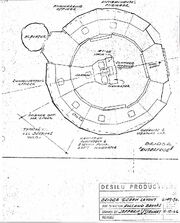
Matt Jefferies' bridge floorplan
"I decided that the crewman would work like in the navy, so often would be on for four hours, off eight hours, and it had better be comfortable. The switches would all be so that the crewman doesn't have to reach for anything. Each of the viewing screens would be at right-angles to his eyes, and we drew a full size section of the bridge that way. I wanted an all-black instrument panel that would light up from behind which is pretty much what we came up with. I did all of the artwork on each one of the instruments, and got the negative, put the color on the negative and mounted 'em under black glass. I was still assembling those things on one side of the bridge when they were shooting the other side..."
One issue with the bridge design is the single offset turbolift. The location does not line up with the Enterprise model, which shows a turbolift alcove directly behind the main bridge. According to Jeffries, this offset placement was necessary to allow characters to walk onto the bridge and photographed without being blocked by actors sitting in the command chair.
Jeffries also mentioned that Spock's sensor hood is a tip of the hat to early radar used by World War II battleships. Ambient room light would wash out the weak signals of early radar imagery, so hoods were used to cover radar screens. Because modern radar imagery is brighter, viewing hoods are no longer needed.
William Shatner, director on Star Trek V: The Final Frontier, had been so impressed with Herman Zimmerman's work on The Next Generation as production designer that he hired Zimmerman to upgrade the Enterprise interiors for the film. Hence, the upgraded bridge from the movie resembles the bright atmosphere portrayed in The Next Generation. For Star Trek VI: The Undiscovered Country, however, the bridge was once more redesigned to reflect director Nicholas Meyer's more militaristic approach on Star Trek.
An Enterprise that never was
A Ralph McQuarrie Enterprise concept art, ultimately rejected in favor of Jefferies' design
Ralph McQuarrie, best known to the public for his stunning production designs for the Star Wars films, was hired by Ken Adam to help develop the designs for a new Star Trek movie, ultimately abandoned to make way for Star Trek: Phase II, the new television series.
Their Enterprise design, however, was abandoned, and Roddenberry asked Matt Jefferies to update the famous starship to reflect the refit that would be part of the series' back story. Jefferies' redesign changed the engine nacelles from tubes to thin, flat-sided modules, and tapered their supports. He also added the distinctive photon torpedo ports on the saucer connector.
Early ads for The Motion Picture portrayed the upgraded Enterprise initially designed for Phase II by Jefferies
"Basically," Jefferies said, "what I did to it was change the power units, and make a slight change in the struts that supported them. I gave the main hull a taper, then I went flat-sided and thin with the power units, rather than keeping the cylindrical shape. Trying to work out the logic of the refit, I knew a lot of the equipment inside would change, but I didn't see that there would be any need to change the exterior of the saucer. Certainly, though, the engines would be a primary thing to change. Part of the theory of the ship's design in the first place was that we didn't know what these powerful things were or how devastating it would be if anything went awry, so that's why we kept them away from the crew. And that meant they could be easily changed if you had to replace one."
Unlike the first redesign of the Enterprise, Jefferies' new version was built this time by Don Loos, who had built the original ship for the original series. But when Paramount Pictures abandoned its plans to create a fourth television network and subsequently transformed the second Star Trek series into the first movie, that Enterprise was packed away as movie director Robert Wise brought in a new art director – Richard Taylor – who assigned Andrew Probert to do a second redesign of the ship, essentially keeping with Jefferies' new lines, while adding the extensive detail that was necessary for a motion-picture miniature.
Creating a Motion Picture Enterprise
For Star Trek: The Motion Picture, a new Enterprise was designed by Andrew Probert, based upon Mike Minor's concepts for Star Trek: Phase II. Other artists who worked on the refit design were Joe Jennings, Douglas Trumbull, and Harold Michelson.

Probert's suggestion for the officers' lounge location

Officers' lounge concept art
As art director Richard Taylor felt that they should stay with the proportions inherited from Jefferies' upgraded Enterprise for Star Trek: Phase II, Probert lengthened the ship with merely a few feet and enlarged the saucer, eventually adding an updated superstructure to the top and bottom of it. Additionally, he came up with the new photon torpedo launcher, redesigned the whole navigational deflector dish area, updated the impulse engine, and added phaser banks around the ship.
One of Probert's key concerns as production illustrator on The Motion Picture was that the sets built somehow conformed to the structure of the starship they were supposed to exist within. Here we see Andrew Probert's development sketches for an officer's lounge in the saucer section's upper dome. Probert's concept art was, however, not used for the movie, and a much cheaper set was constructed for the scene.
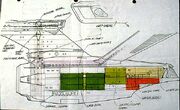
Cutaway sketch
Probert's main contribution for the Enterprise interior came in the form of the vessel's cargo deck, thoughts on which had already been visualized by veteran Mike Minor, before Probert had a chance to address it. Minor worked at the Paramount lot, while Probert was at the Robert Abel special effects facility designing various pieces of space hardware.
The thinking, then at Paramount under production designer Harold Michelson, was that the cargo bay would be a space 30 feet high that had two walls with twelve holes containing cargo pods. Mike Minor's cargo deck design shows us cargo pods simply stacked or lined up on the deck, leaving a huge open and unused space above. The walkways along the sides were also rather old fashioned looking.
The image to the right shows the plate of the cargo deck scene, filmed from Kirk's perspective as he enters the new Enterprise. What Andrew Probert was required to do was to get a frame of plate film and have it printed at a pre-determined size. Part of this frame, required for the live action elements, would be cut out and pasted to a piece of illustration board. The remaining blank board, intended to be the matte, would then be painted around that piece, blending the two together.
Following a discussion with Douglas Trumbull examining the logic of the early cargo deck concepts, this elevation sketch of the Enterprise was drawn by Andrew Probert upon Trumbull's question how the pods would get in and out of the cargo deck. What Probert proposed was that the landing bay and cargo deck be connected, allowing the easy passage of cargo trains.
The idea was that shuttles would normally take off from and land in the landing bay. They then could be lowered to the Hanger Bay level, or lowered another level to shuttle maintenance. A multi-paneled two-story door, between the elevators and cargo bay, has been opened to the sides allowing the transfer of cargo.
Studio Models
Over the course of TOS and the first six Star Trek movies several studio models have been created to represent the Constitution-class, in particular the USS Enterprise, more even than any other class.
The three-foot model
After final approval of his design, Jefferies went on to produce a detailed set of construction blueprints with orthographic views of the ship and send it off to the Howard Anderson Company who were to build the pre-production model (The blueprints published in Star Trek: The Original Series Sketchbook, pages 70-71, were erroneously identified as those. They are in fact post April 1966 construction blueprints drawn up for AMT/Ertl's production shop for making molds for a later edition of their first Enterprise model kit, being printed on the side of the box for the modeler's reference sake). Richard C. Datin, Jr. (who still owns a set of the original blueprints) was eventually subcontracted to build the, soon to be known as "three-foot" model of the Enterprise, though its actual size would be 33 inches exact.
As Datin recalls: "All lettering and the logo artwork on the secondary hull were decals. The rest, I believe, were painted on, such as the hatch indications.(...)I began work on the small Enterprise on Wednesday, November 4, 1964, and completed it by November 15 for a total of 110 hours of my time. Since I did not have a large enough wood lathe to turn out the major components (the primary an secondary hulls and nacelles), I subbed this to an old-time woodworker whose name, unfortunately, escapes me. My portion of the work was assembly, painting, and decorating. The three-footer was comprised of pattern pine-a sugar pine-primarily because it was kiln dried, free of knots, and consisted of a very fine grain. It finishes well and takes paint just as good. I was able to purchase a Plexiglas dome, a ready-made item for modelers, for the bridge. The deflector dish and secondary hull front cover were fabricated from rolled brass strips and silver-soldered together, the sprayed with a gold color lacquer." (Star Trek: Communicator, No.132, 2001, page 51) The paint schemes were selected by Jefferies. After review by Roddenberry, Datin did some minor revisions and delivered the model on 14 December 1964 at a total estimated cost of $600.
Although never slated for filming purposes, but rather to serve as a study model for the yet to be build larger model and for public relations purposes (including well publicized publicity shots of Shatner and Nimoy holding the model), it eventually was used as such. A time line drawn up by David Shaw elaborated: [2]
- 4 Nov 1964 (Wednesday): Richard Datin agrees to build an approximate three foot long model based on an early set of plans which give a real world scale of 1:48 (if this had been the final drawings, this would have been the 540' version, but the proportions of this early drawing are actually significantly different from the final plans).
- 7 Nov 1964 (Saturday): The final construction plans are finished. These plans include the scale reference of FULL SIZE & 3" = 1'-0" TO LARGE MINIATURE.
- 8 Nov 1964 (Sunday): Richard Datin receives the plans and starts building the full size 33-inch model out of kiln-dried sugar pine.
- 15 Nov 1964 (Sunday): A little more than a week later the 33-inch model is presented to Roddenberry for approval. This may have been when the addition of exterior windows was requested (which were not part of the original design), and the model returns with Datin after the viewing.
- 8 Dec 1964 (Tuesday): Construction is started on the 11-foot model.
- 14 Dec 1964 (Monday): The 33-inch model is delivered to Roddenberry for final approval while "The Cage" is being filmed in Culver City (there are images of Hunter and Roddenberry examining the model on this date). This model is used for all effects shots in "The Cage" except the most important one (the zoom in on the bridge).
- 24 Dec 1964 (Thursday): Shooting of "The Cage" wraps, only one effects shot still outstanding (all other model shots use the 33-inch model).
- 29 Dec 1964 (Tuesday): The 11-foot model (built by Datin, Mel Keys, and Vern Sion) was delivered to the Howard A. Anderson studio. This version is not powered and the windows are painted on the surface of the model. Even then the model was designed to be shot from the right side only.
- 23 Jan 1965 (Saturday): After "The Cage" is already in the can and waiting for network approval of the new series, additional test shots of the 11-foot model are taken in its original condition.
- 30 Jan 1965 (Saturday): Aspects of the ship's size (like it being 190,000 tons) were being distributed to the media in the descriptions of the new show.
Recognizing her use for forced perspective shots, Anderson shot stock footage for use in the title sequence and future episodes. Besides "The Cage", the model would appear most notably in "Where No Man Has Gone Before", "Tomorrow is Yesterday", "By Any Other Name", and finally in "Requiem for Methuselah", ironically here as a desktop table model. In the episodes after the two pilots the three-footer can be recognized by the fact that she, unlike her big sister, is not lit internally.
In August 1965 and April 1966 a series of revisions were made to the eleven-footer, which were mirrored onto the three-footer, except for the internal lighting and the animated nacelle domes, which were deemed too expensive.
After cancellation of TOS, the three-footer was given by the studio to Roddenberry. Reportedly he loaned the model to somebody during the late 1970s, but has forgotten to whom. The model has been missing ever since.
The eleven-foot studio model
After the first review of the three-footer, Roddenberry green lighted the construction of the large model, which would be exactly four times the size of the small model. Again Richard Datin was entrusted with the job. This time however he was forced due to time restraints and the limitited size of his own workshop, to subcontract the bulk of the construction. The company he choose was Burbank based Production Models Shop, owned and operated by Volmer Jensen. Most of the work would fall on his employees Mel Keys and Vern Sion, closely supervised by Datin.
On constructing the "eleven-footer", Datin remembers: "The saucer section was constructed in two seperate halves, top and bottom sections, of "Royalite" plastic sheet vacuum-formed over plaster molds, each representing the top half and bottom half of the saucer. The formed sheets in turn were supported, or held together, by a series of plywood ribs or struts radiating from the center. I have no idea how many ribs there wher, but a sufficient number to support the nearly one-eighth-inch thick sheet of Royalite. The plastic surface was thin enough to be slightly pressed inward with a finger.(...) At the point where the (solid wood) dorsal connected to the underside of the saucer, additional framework was added to strenghten the connection to the saucer. The dorsal was fastened to the saucer by one or two, most likely two, lag screws whose heads were set in below the top exterior surface of the the saucer. A small, low profile section made of wood hid the screws. The teardrop-shaped bridge section was made from a solid piece of wood with in its center hollowed out for installation of the hemispherical-shaped Plexiglas (bridge) dome (the same for the underside dome)...."
"The two engine nacelles consisted of a tapered frame constructed of plywood ribs fastened to the respective shaped solid wood ends," recalls Datin further. "The nacelle surfaces that faces each other were flat elongated areas of wood that were set in from the outer skin surface. Other details were added, such as what looked ans was described as wood shaped "handles", which Gene took an instant dislike at my terminology. But to me no better description fits ! The rib frame was the covered with a heavy gauge pre-rolled sheet metal. A formed corrugated Plexiglass sheet covered the sides of the "S"-curved aft ends, while the forward domes were comprised of a semi-hard-wood-like ash and lathe-turned into hemispherical-shaped half domes.(...)The two support pylons were made of a solid one-piece hardwood, of either oak or walnut for strength." (Star Trek: Communicator, No.132, page 53)
The wooden secondary hull was subcontracted out, as well as several component pieces such as metal bits on the nacelles. The spikes on the forward nacelle domes were made by Datin himself. The same paint scheme as for the three-footer was applied, but no decals were used on this version, all the details on the hull, lettering, logos and all were painted on. Virtually identical to her smaller sister, the eleven-footer lacked one detail. The surface on the backside of the aft nacelle caps was smooth, where the three-footer, as per specification, sported a detailed rectangular feature. Coming in at a length of 11ft, 2.08inch and a weight of 225 pound the model was delivered to Anderson on 29 December 1964. Too late for extensive use for "The Cage", the model was stored away for months while the studio pondered the fate of Star Trek. Once the decision was made to have a second pilot made, Roddenberry with the people at Anderson's decided to enliven the large model in order to enhance their chances. Up to then he didn't want any of the models to be internally lightened and the models were delivered as such, however he changed his mind about that. Again Richard Datin was called in to do the proposed revisions. Datin logged in another 88 hours of his work from 27 Augustus to 8 September 1965, doing the following:
- Bridge: several painted-on windows removed, light panels added in front and on sides.
- Saucer top: nav lights added, black bands painted near port & starboard edge, painted black & white areas added near bow edge, four light panels added. The port & aft light panel was just painted-on and is not an actual light panel.
- Saucer rim: centermost bow port changed to nav light, some windows added.
- Saucer bottom: nav light & 2 portholes added near edge on each side, at 10 and 2 o'clock positions.
- Impulse engines: black rectangular vents painted over with hull color, eight small round black vents painted on.
- Secondary hull: strobe light added on aft flank, rearmost round porthole moved from left side of two rectangular ones to right side.
- Nacelles: black "grille" pattern painted on rear nacelle end caps.
- Registry markings were previously painted-on, now changed to decals.
The moment Star Trek was to become a regular series early 1966, Roddenberry wanted to enliven the model even more, this time also retrofitted to the "three-footer". Yet again Datin was called in to do the revisions, What he did was this:
- Bridge: bottom half chopped off, light panels removed, a red "beacon" added on each side. Some portholes added on B&C decks.
- Saucer top: black bands and most other painted-on markings removed, a round light panel added near bow edge, rib added on "linear accelerator" and both painted a darker gray.
- Saucer rim: Some portholes added, bow nav light replaced by light panel
- Saucer bottom: nav lights moved to 9 and 3 o'clock position, some portholes added, "nipple with phaser turret" added below sensor dome.
- Impulse engines: painted darker gray, round vents removed, original rectangular vents again painted black, texture wraps added on both ends of impulse deck.
- Dorsal: some windows/portholes moved/added, dorsal painted same as rest of hull instead of the earlier bluish reflective color, with a darker region on both leading & receding edge.
- Secondary hull: red "beacon" & green portholes added on top, some windows/portholes added, deflector dish diameter reduced, "observation booth" added under cowling above hangar bay doors.
- Nacelle pylons: four dark gray. brick-pattern inserts placed in slots.
- Nacelles: solid wood "power nodules" with spikes replaced with frosted plexiglas domes with inner surface painted transparent orange, plus motorized vanes and blinking Christmas lights added behind the dome[3]. The original wooden domes are still in the possession of Richard Datin.
- Ribs and aluminum grille added in "trenches" along inboard flanks of nacelles and trench painted darker gray., patterned slabs added inside "intercooler loops" at rear, small slabs added in front of intercooler loops, black painted grille removed from end caps and light gray. spheres added.
- Typeface used for registry markings changed, weathering added.
These revisions are the ones also retrofitted onto the three-footer, save for the lighting options which were deemed too expensive. In this vane the eleven-foot Enterprise -model would be used for the rest of the series, save for minor revisions done at Anderson's during the run of the series:
- Upper sensor dome changed to a taller one, registry numbers on saucer bottom switched around so the starboard one was readable from a front view.
- Jefferies came up with a "deflector grid" which was drawn in pencil on the primary hull. It was drawn only to satisfy Roddenberry and was done very lightly so it wouldn't be visible on film.
Apocrypha
- Saucer separation for the Constitution-class, suggested by the ship's design but never seen on film, has made canonical and non-canonical appearances. in the TOS episode "The Apple", the episode's original script called for an emergency saucer separation. However, due to budgeting, the effect was only mentioned but not seen. In the DC Comics Star Trek: Debt of Honor, Kirk used "explosive bolts" to sever the connection between the saucer module and the engineering section of the USS Farragut. The same trick was used again in the DC Comics Star Trek: The Mirror Universe Saga, where Kirk and his crew escaped the self-destruction of the ISS Enterprise's engineering section in a last-minute separation. Another Constitution-class ship, the USS Confederate, was shown operating without its saucer section in Marvel Comics Star Trek Unlimited Issue 4; after the crew abandoned the engineering hull via saucer separation due to a failure in an experimental propulsion system upgrade. In the early drafts of Star Trek: The Motion Picture, the Enterprise was to separate the saucer. The 2006 Star Trek: Ships of the Line calendar includes a picture of a separated Constitution-class ship, engaging Klingons – or possibly a Klingon ship flown by the Romulans – in battle.
- Another saucer separation sequence was envisioned by Andrew Probert in 1978 when the script for Star Trek: The Motion Picture was in flux. During a lull in script development Probert came up with an alternative scene in which V'Ger releases a Klingon Battlecruiser. Upon re-materialisation the Klingons true to their nature immediately attack the Enterprise. During the battle Kirk is forced to a perform a maneuver akin to Riker's in "The Best of Both Worlds, Part II". Douglas Trumbull liked the idea and had Probert draw up color story-boards to show the sequence. Some of the story-boards are published in Star Trek: The Magazine Volume 1, Issue 22, page 132.
- In two instances the suspected saucer separation capabilities of the Constitution-class came very close to becoming canon. The first instance occurred in footage of the debris field shown in Template:EpLink; Both the engineering hull and the saucer section separated from each other have been positively identified as belonging to the Constitution-class [4]. However since it can also be argued that this could have resulted from battle damage it remains non-canonical. The second instance concerned the USS Olympia whose crashed saucer section could be seen in Template:EpLink along with a severed nacelle from a Constitution-class starship(those two parts already having been used as debris of the exploding USS Odyssey in Template:EpLink). A behind-the-scenes photo clearly showed that the saucer landed in the same fashion as the Enterprise-D in Star Trek Generations[5] (the model landscape build by Gregory Jein). But again, since the visuals are open to multiple interpretations and since the ship is not further commented upon (neither in dialogue or computer read-outs), the capability remains debatable. In both instances (parts of) the battle-damaged version of the studio model, slightly modified, of the Enterprise from Star Trek III: The Search for Spock were used (photos in Cinefantastique Vol.28, No4/5, page 64 and Vol.25/26, No.6/1 page 109).
- The Constitution-class is also present in the alternate Star Fleet Universe, where it served as the backbone of Starfleet from its inception in the Y120s to the advent of the General War and the related deployment of the Chicago-class New Heavy Cruiser. In the Star Fleet Universe, the Constitution design is descended from the Republic-class cruiser, the first in that universe's Federation fleet to possess the saucer and nacelle configuration. (Some of the older ships were refitted into Constitution-class ships over time, while others became part of the Federation National Guard, protecting the major member worlds.) In time, the advent of more advanced technology resurrected the ship design through the Vincennes-class vessels, a parallel evolution to that seen in the change from the TOS-era Enterprise to the TMP ship design. Notably, a number of the ships referred to in the original series (such as the Hood and the Excalibur) or listed in the Technical Manual (such as the Kongo) are expanded upon in the Star Fleet Universe – but due to the licensing restrictions under which ADB operate, the Enterprise herself is not detailed, though her registry is included.
Constitution-class registry
Although not considered canon, several sources have produced a long list of Constitution-class starships. The main source was Franz Joseph's Star Fleet Technical Manual, which listed over 100 Constitution-class ships divided into sub-classes: Constitution, Bonhomme Richard, Achernar and Tikopai. Ships of the class were later expanded by other publications such as Ships of the Star Fleet which included the Endeavour, Enterprise, and Enterprise (II) sub-classes.
- Constitution-class ships:
- USS Constitution (NCC-1700)
- USS Constellation (NCC-1017)
- USS Republic (NCC-1371)
- USS Enterprise (NCC-1701)
- USS Farragut (NCC-1702)
- USS Lexington (NCC-1703)
- USS Yorktown (NCC-1704)
- USS Excalibur (NCC-1705)
- USS Exeter (NCC-1706)
- USS Hood (NCC-1707)
- USS Intrepid (NCC-1708)
- USS Valiant (NCC-1709)
- USS Kongo (NCC-1710)
- USS Potemkin (NCC-1711)
- USS Bonhomme Richard (NCC-1712)
- USS Monitor (NCC-1713)
- USS Hornet (NCC-1714)
- USS Merrimac (NCC-1715)
- USS Endeavour (NCC-1716)
- USS Defiant (NCC-1717)2
- USS Excelsior (NCC-1718)
- USS Eagle (NCC-1719)
- USS Lafayette (NCC-1720)
- USS Wasp (NCC-1721)
- USS El Dorado (NCC-1722)
- USS Ari (NCC-1723)
- USS Saratoga (NCC-1724)
- USS Tori (NCC-1725)
- USS Krieger (NCC-1726)
- USS Essex (NCC-1727)
- USS Truxton (NCC-1728)
- USS Confiance (NCC-1729)
- USS Bunker Hill (NCC-1730)
- USS La Vengeance (NCC-1731)
- USS Achernar (NCC-1732)
- USS Sol (NCC-1733)
- USS Jupiter (NCC-1734)
- USS Rigel Kentaurus (NCC-1735)
- USS Quindar (NCC-1736)
- USS Proxima (NCC-1737)
- USS Androcus (NCC-1738)
- USS Astrad (NCC-1739)
- USS Mondoloy (NCC-1740)
- USS Alfr (NCC-1741)
- USS Thelonii (NCC-1742)
- USS Xanthii (NCC-1743)
- USS Sirius (NCC-1744)
Footnotes
1 There may only be twelve Constitution-class ships as of "Tomorrow is Yesterday", but the line this is drawn from ("there are only twelve like it in the fleet") possibly suggests that the Enterprise should be excluded from the count, meaning there could be thirteen Constitution-class ships as of that date. It also may or may not exclude ships that were no longer in the fleet due to destruction or other reasons. However, The Making of Star Trek clearly states that at the time of the series' production, the intent was that there were only twelve ships, the Enterprise included. Or, this maybe just a reference to twelve other ships of that type; given that many variants of one ship can exist at the same time.
2 The Star Fleet Technical Manual lists the Defiant as NCC-1717, although it was labeled on screen as NCC-1764.
- Registry numbers: Although the Star Trek Encyclopedia and other references provide complete registry numbers for many Constitution-class ships, these numbers are at best conjecture. Many of the Encyclopedia's numbers were derived from Greg Jein's "The Case of Jonathan Doe Starship," which assumed that the list seen on the wall at Starbase 11 in "Court Martial" were all Constitutions.
- Uncertain ships: These ships have been listed in various references as Constitutions, but were never seen on screen as such, and are therefore of uncertain class.
- "Starship"-class: If you read the dedication plaque on the bridge of the original Enterprise, it was actually listed as "Starship Class". The term "Constitution-class" came later, probably from "The Trouble with Tribbles", where the display that Scotty is reading shows a phaser bank diagram for a "Constitution-class" starship (according to an article by Greg Jein in a 1975 fanzine, that artwork also appeared in earlier episodes). Though it was "understood" to have been Constitution-class by both production staff, the first time it was actually referred to as such was by Captain Jean-Luc Picard in TNG: "The Naked Now". In "In a Mirror, Darkly" the Dedication plaque of the USS Defiant (NCC-1764) clearly states that she belongs to the Constitution-class (In "The Tholian Web", the plaque, which was of course Enterprises, could not be seen due to deliberate camera angles). Not being one of the ships listed in the original final names list (The Making of Star Trek, page 165) used by the production team of TOS, and although not being Canon, this suggested two things; Firstly Starfleet changed its nomenclature from Starship-class to Constellation-class during the run of TOS and secondly, the Defiant belonged to a later batch of Constellations (supported by the fact she has the highest registry number of all the definitively established Constellations). Commisioned somewhere during TOS, she therefore had an unfortunately short career (At least in Treks prime universe).
- USS Yorktown: Gene Roddenberry suggested that the USS Enterprise-A was first designated as USS Yorktown, and later recommissioned as USS Enterprise-A, probably because Yorktown was one of the names for the ship being considered when TOS was going into production. Roddenberry felt that it would have been very unlikely that a brand new ship would have been constructed so fast after the destruction of the original Enterprise. Would this had become canon, the Yorktown would have been definitively been established as a Constitution-class vessel. This practice of Starfleet renaming a vessel for a very deserving other vessel was later established in DS9, when the USS São Paulo was rechristened USS Defiant as the latter was destroyed in the Dominion War.
- On a side note; The World War 2 carrier USS Enterprise (CV-6), after which Roddenberry named the NCC 1701, was a sistership of the USS Yorktown (CV-5), belonging to the same "Yorktown"-class (the other one being the USS Hornet (CV-8), a name also considered by the aforementioned staff in an earlier draft of the names list,´´The making of Star Trek´´page 164).
See also
- Constitution-class decks
- Template:ShipClass
External links
- Designing the Enterprise at Forgotten Trek - about Matt Jefferies' design of the Enterprise for The Original Series
- Redesigning the Enterprise at Forgotten Trek - about the design of the refit Enterprise for The Motion Picture
- Template:NCwiki
Revision ID missing! • Date missing! • Blurb

